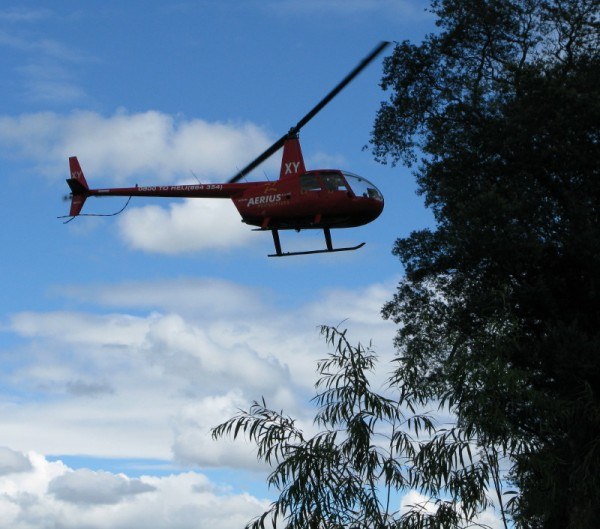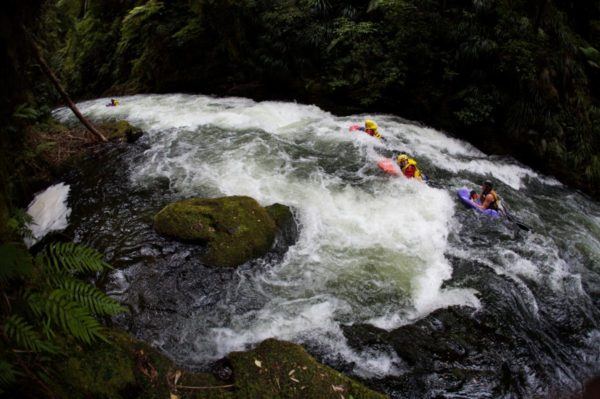We really had no idea what lay in store for us when we were driven to Kaitiaki Adventures headquarters for the day.
This post was originally published in 2010. It has since been updated for accuracy of links and content.

Our small television crew of three were cordially received by a confusing myriad of people who fitted us (which basically meant looking us up and down then sifting through their racks) for wetsuits, booties, fleece layers, cags, helmets, flippers, and life jackets before piling everything (including us) into the back of a van and speeding off.
It was at this stage that we got a chance to chat with our guides for the day: Joel – a blonde haired guy with a wide smile, Geni – a beautiful girl of Maori descent with the most muscular arms I had ever seen on a woman, and Adam – whose nickname was “Chonk” (which we were led to believe had something to do with his missing tooth).
We also got a chance to pick our guides’ brains as to exactly what lay in store for us today.
We discovered that we were headed for the Okere Kopia, which is the lower section of the Kaituna river. Lots of rafting companies do the Kaituna, but Kaitiaki is the only one with the rights to the Okere Kopia section. It’s very hard to access – as we discovered – and it’s sacred Maori land.
“Kaitiaki” actually means guardian or caretaker, and it became evident throughout the day that the Kaitiaki Adventures guides paid special attention to the traditions and rites of this very special place.
Shortly after unloading the van and putting on layer after layer of gear, a red helicopter came in to land nearby. This was to be our taxi to the Okere Kopia. After strapping various pieces of gear to the outside and piling Aaron, Fletcher, and Joel inside, it effortlessly lifted off and they disappeared beyond the trees.
This was my chance to sit down and chat with Geni. She was a beautiful girl who exuded a quiet air of strength and confidence. I asked how she got into whitewater river guiding.
“I took an introductory outdoor education course and immediately loved the whitewater,” she said. “I knew I wanted to do more and asked about becoming a sledging guide. I was told that I couldn’t do it because I’m a girl and I wouldn’t be strong enough. Nobody tells me that I can’t do something, so I went for it and became the first female sledging guide in New Zealand.” She’s still the only female sledging guide, and over the day I developed a great admiration for her strength and abilities.
“I once had to tow a 130kg guy down the whole river. He just couldn’t do it,” she said of some of the challenges she’s faced in her sledging career. “Aaron might have some trouble today, but he’ll be easy in comparison,” she said of the host of “Alive”, who would be doing the majority of the sledging. Fletcher (the cameraman) and I would get a chance to sledge too, but also ended up spending a fair bit of time in the raft, getting the right shots. Given the number of guides we had and the isolation of the river (and ability to get rescued if something went wrong), there needed to be two guides in the river for every person sledging through most of it.
“What class of river are we rafting/sledging today?” I asked. I had rafted some epic whitewater in Ottawa and British Columbia (Canada), but had never actually been IN the whitewater as with a sledge (which is basically a glorified boogie board), and I was a bit nervous.
Chonk jumped in to answer this question: “Whitewater ratings are subjective. It depends on the drop, how much water there is, what the hazards are, and what the ability to get rescued is. We’re gonna be on a very remote piece of river, so that ups the rating. We’ll get some good class four in there, but the first few kilometers are a littler easier and some of it is almost flat. It’s a good mix,” he replied.
I got a surge of butterflies in my stomach – a sign of good things to come, in my books.
When the helicopter ferried back to us, we tied more gear to the outside and piled in while the prop remained running. Even though I didn’t necessarily need to, I enjoyed ducking my head down to avoid the prop blast, as I’d always seen done on television. It just seemed like the right thing to do. The “cool factor” was over the top, and we hadn’t even lifted off.
The ride out to our spot on the river was bloody marvelous. We cruised over gorges and valleys, and occasionally got a glimpse of the 10km stretch of river that we’d be on (er…in) in a short time.
After unloading and carrying our gear a five minute walk to the river, we got our crash course in sledging on the beach. We had already been drilled on the three golden rules of sledging:
Rule #1: Don’t let go. (The sledge floats much better than you do).
Rule #2: Turn your head when going down rapids. (Otherwise the sledge can kick back and break your nose. In fact, one of the rapids on this river was named “The Nose-breaker” after an unfortunate client who neglected to follow this rule.
Rule #3: Don’t let go. (Yes, it’s that important).
Beyond that, we learned some techniques to control ourselves and bail the sledge out if it took on too much water (which at some point or other, was bound to happen).
Before launching, Geni sang a Karakia (Maori prayer), paying respect to the people of the river – past and present – and asking for protection and guidance. It couldn’t have been more perfect, and we all were moved by this ritual, which made us both nervous for what was to come, as well as confident that we were in good hands (spiritual and otherwise).
Chonk, Fletcher, and I launched in the raft, and Geni, Joel, and Aaron started practicing sledging techniques in the water. The rafting was great fun, and I got my “water legs” quickly. Having been rafting twice before, I was still nervous, but Chonk made it look easy, and Fletcher was so distracted with getting amazing shots on his various waterproof cameras that he almost didn’t notice the class three rapids we kept catapulting over.
A couple of kilometers in, we pulled over to the side while Aaron cruised by on the sledge. His exhaustion became evident when he looked wearily up at me and said “Switch up. Switch up. I know you want to try sledging.”
I smiled and said “No worries mate. Keep on at it – looks like you’re having fun!” Poor Aaron – he was learning the hard way what a workout sledging is, and I had to admit I found his exhaustion alarming and wondered how I’d fair myself. I knew I’d get my chance, and was simply waiting for the guides to make the call. They knew the river best and when the appropriate time to switch would be.
As we all cruised down the river, we got to know the guides (and vice versa), and they relaxed once they realized we were pretty easy-going and fun-loving. I knew we had reached a new level of friendliness when I felt a tug at my back as Joel pulled me into the river from his sledge. His efforts weren’t as successful as he had hoped though, as I had so successfully wedged my foot to secure myself in the raft that I was left hanging backwards over the side of the boat, head in the water and feet in the boat, laughing and sputtering.
“Gotta watch Joel like a hawk…” was Chonk’s (somewhat obvious) advice to me. I was having the time of my life already, and the appeal of becoming a whitewater guide grew along with our rapport.
After rafting a class four section called “Smokey Falls” – our most challenging rapid yet – we pulled the raft over to the side with a great deal of effort, and Chonk and I climbed up the bank so I could use one of the cameras to get a shot of Aaron approaching the falls in the sledge. Chonk then left me and clambered back down to the boat to ferry he and Fletcher to the other bank further down for the shot of Aaron coming out of the falls.
Standing alone on the bank, camera in hand and waiting to give the signal to Geni and the crew upstream that we were ready for them, I wondered exactly how I’d be getting off this bank with the raft now a fair bit downstream.
But I had other things to worry about (like getting a good shot), so I put it out of my mind. I gave them the signal, and a few minutes later the sledgers cruised over the massive plume of whitewater that is Smokey Falls.
They pulled over to the same bank where I had gotten out, and before I knew it Joel was at my side carrying two sledges. “Okay, you ready?” he said.
“Um….here?” I said, bewildered. Joel was already strapping flippers on my feet.
“Yep.”
“Here? Smokey Falls? Class four? Don’t you think I should practice some of the drills in calmer water or something? You know I haven’t ever sledged, right?” I said, wondering why on earth I said I’d like to sledge a few hours earlier.
“Don’t worry. It’s pretty much a matter of pointing down the river and hanging on,” Joel said, and with that he gave me a push before I could consider my fate for much longer.
I’m not sure how long I was underwater or which way I was facing, but I followed the golden rules (#1: Don’t let go; #2: Turn your head; #3: Don’t let go), and emerged the other side victoriously, with a huge grin on my face. I survived!
Over the latter half of the river, we all got a chance to sledge through both calm and white water. In the calm water, we chatted, joked, and even had time for a snack.
Shortly thereafter we entered a sacred Maori burial ground, where we were told we couldn’t speak (out of respect). This very narrow section of river was lined with massive moss-covered cliffs on either side. We looked around in awe at the stunning scenery, and even silently pointed at shapes in the rock that looked like faces. We felt the serene spiritual energy of the area, and even if we wanted to speak, our voices seemed to have been silenced. We mouthed the word “wow” and “amazing” over and over again.
Shortly thereafter I was in the raft again with Joel and Chonk, while Aaron, Fletcher, and Geni sledged a fairly gentle section. By this stage Joel and Chonk must have deduced that I’m pretty easy going, because staying in the boat was not an option. I was duped when Joel thought he saw a leak in the bottom of the boat, got me to unhook my foot, then tackled me out.
“That was too easy!” he said victoriously. I laughed while he pulled me halfway back in, then let me go again. At least the water was warm.
After four or five hours of rafting and sledging (something that felt more like two hours), we pulled over to the side and organized our gear. I heard the roar of a motor and saw a jet boat come skidding around the corner leaving an impressive spray of water as he did a 180 degree turn and stopped on the spot.
If the first 10km of river took us five hours, the last 12km took us five minutes in the jet boat. Keeping our eyes open with the velocity of wind in our faces was challenging, and with every turn we felt we’d surely run aground on the shallow banks. But of course, the driver knew this river well, and we were in no danger. It was all part of the adventure.
We were sad to see the tour come to a close as we unloaded the boat, stripped out of our wetsuits, and loaded up the van once again to return to Rotorua. We had such a great time with Geni, Chonk, and Joel that we even ended up meeting them (and a few other Kaitiaki Adventures guides) at the local bar that night for drinks. Temporarily being a part of this fun-loving and adventurous crew made me yearn to join them and become a sledging guide myself. This (to me) was the sign of a perfect day – and one I won’t soon forget.
Editor’s Note: This experience was part of a week-long trip organized by Destination Rotorua Tourism Marketing in conjunction with shooting an episode of the tv show “Alive”. I’d do it again in a heartbeat and pay full price for it. The whitewater sledging pictures were provided courtesy of Destination Rotorua Tourism Marketing.
Here are some other New Zealand Adventures you may be interested in:
The World’s Longest Abseil into a Cave to Spot Glow Worms
Crater Walking on Mount Tarawera






That looks like a blast! We have got to get ourselves to New Zealand one day soon! Congrats on shooting an episode for Alive, I will have to check it out when we get back to Canada. Too Cool!
@Dave & Deb – Thanks! The trip was a true adventure, and the impetus to immediately come back to New Zealand (where I still am)! Stay tuned for more of my crazy adventures…
PS – Unless you have direct tv, I’m not sure Alive will air in Canada. But rest assured – I’ll have all the details when they are released, and hopefully a few clips here on the site! 🙂
Wow! What an experience! It looks like you had a lot of fun! Can’t wait to see the show!
Coolest day Nora!!! WoooHoooo!!! Great yarn and so. much. fun.
Off to book my tickets to NZ…..
@JoAnna & Frank – It was truly the coolest day. I truly enjoyed it!